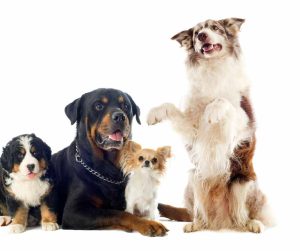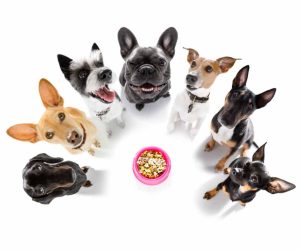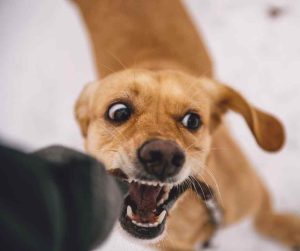Furry companions come in all shapes and sizes, each with their own unique characteristics. However, when it comes to bite force, some breeds stand out above the rest. Let’s explore the top 10 dog breeds with the strongest bite force, from the well-known German Shepherd to the often misunderstood Pit Bull.

Understanding the Science Behind Bite Force: How Dog Breeds Compare
Table of Contents
Bite force is a term that refers to the amount of pressure a dog’s jaw can exert when biting down. It is an important aspect of a dog’s anatomy and can vary greatly among different breeds. Understanding the science behind bite force can provide valuable insights into a dog’s behavior and capabilities.
Firstly, note that a dog’s jaw muscles’ size or strength does not solely determine bite force. In fact, the shape and structure of a dog’s skull and teeth play a significant role in their bite force. Dogs with larger heads and wider jaws tend to have a stronger bite. Tthey have more space for powerful muscles to attach to.
One of the most commonly asked questions when it comes to bite force is:
“What breed has the strongest bite?”
Researchers have studied bite force in various dog breeds, but there is no definitive answer to this question. A study found the Kangal, a large Turkish breed, had the highest recorded bite force at 743 pounds per square inch (psi). This is significantly higher than the average bite force of a domestic dog, which ranges from 150-200 psi.
Breeds like the Rottweiler, American Pit Bull Terrier, and German Shepherd are known for their strong bite force. Breeders originally bred these breeds for tasks like guarding and protection due to their powerful jaws.
On the other hand, smaller breeds such as the Chihuahua and Pomeranian have a relatively weaker bite force, ranging from 12-20 psi. Their size and skull structure limit powerful biting, not designed for such force.
It is also worth noting that a dog’s bite force can vary depending on the situation. Dog’s bite force might be higher when defending territory compared to during play or eating. Age, health, and training can also influence a dog’s bite force.
Understanding the science behind bite force can also shed light on a dog’s behavior. Dogs with strong bites may show more aggression, having the physical ability to cause harm. This is why it is important for dog owners to properly train and socialize their pets, regardless of their breed.
From Chihuahuas to Rottweilers: A Look at the Top 10 Dog Breeds with the Strongest Bite Force
When it comes to dogs, there are many factors that make each breed unique. Size, appearance temperament and intelligence, every breed has its own set of characteristics that make them stand out. One aspect that is often overlooked but equally important is a dog’s bite force. A dog’s bite force indicates jaw pressure, crucial for strength and potential as a working or guard dog. Here are the top 10 breeds.

Chihuahua
Despite their small size, they can exert up to 390 pounds per square inch (psi). Due to their large head and strong jaw muscles, making them one of the smallest breeds with a powerful bite.
Dachshund
Another small breed that packs a punch is the Dachshund. These long-bodied dogs, known for their hunting abilities, have a strong bite force of up to 700 psi. Breeders bred their long, powerful jaws for digging and catching prey.
Doberman Pinscher
Known for their loyalty and protective nature, Doberman Pinschers also have a strong bite force of up to 600 psi. This is due to their muscular build and powerful jaws, making them an ideal breed for guarding and protection work.
German Shepherd
German Shepherds are not only intelligent, but they also have a strong bite force of up to 238 psi. This is due to their large head and powerful jaw muscles, making them excellent working and police dogs.
American Pit Bull Terrier
Despite their controversial reputation, American Pit Bull Terriers have a bite force of up to 235 psi. This is due to their strong, muscular bodies and powerful jaws, making them a popular breed for protection and fighting.
Siberian Husky
Known for their endurance and strength, Siberian Huskies also have a strong bite force of up to 320 psi. Their large head and powerful jaws make them ideal for pulling sleds and heavy loads.
Boxer
With their muscular build and strong jaws, Boxers have a bite force of up to 230 psi. This makes them an excellent breed for protection and guarding, as well as for their playful and energetic nature.
Mastiff
Mastiffs have a strong bite force of up to 556 psi. This is due to their massive size and powerful jaws, making them an ideal breed for guarding and protection work.
Rottweiler
Another large and powerful breed, Rottweilers have a bite force of up to 328 psi. This is due to their muscular build and strong jaws, making them an excellent breed for guarding and protection work.
Kangal
Topping the list with the strongest bite force of any dog breed is the Kangal. A force of up to 743 psi. This is due to their large size and powerful jaws, making them an ideal breed for guarding and protecting livestock.
The Role of Genetics and Evolution in Determining a Dog’s Bite Force
Genetics and evolution play a significant role in determining a dog’s bite force. The strength of a dog’s bite is influenced by various factors:
- Breed
- Size
- Shape of their skull
- Jaw muscles
- Teeth
These factors are all determined by genetics and have evolved over time to suit the specific needs and functions of different dog breeds.
One of the main factors that contribute to a dog’s bite force is the size and shape of their skull. Dogs with larger skulls and wider jaws tend to have a stronger bite force compared to those with smaller skulls and narrower jaws. This is because a larger skull provides more space for powerful jaw muscles to attach, giving them more leverage and strength when biting down.
Another important factor is the shape and size of a dog’s teeth. Different breeds have different types of teeth, such as sharp incisors, strong canines, and powerful molars. These teeth are designed to perform specific functions, such as tearing, gripping, and crushing. For example, breeds like the Rottweiler and Pitbull have strong, wide jaws with large, sharp teeth that are ideal for gripping and holding onto prey. In contrast, breeds like the Greyhound and Whippet have narrower jaws with smaller, pointed teeth that are better suited for tearing and slicing.

The strength of a dog’s bite is also influenced by their jaw muscles. Dogs with larger, more developed jaw muscles have a stronger bite force compared to those with smaller, less developed muscles. This is because the jaw muscles are responsible for closing the jaw and exerting force when biting down. Breeds like the Mastiff and the American Bulldog have powerful jaw muscles that can exert a tremendous amount of force, making them some of the strongest biters in the canine world.
The evolution of different breeds showcases the role of genetics in determining a dog’s bite force. Breeders selectively bred dogs over time for hunting, guarding, and herding.This selective breeding has resulted in the development of different physical characteristics, including bite force. For example, breeds like the German Shepherd and the Doberman Pinscher were bred for their strong bite force, making them excellent guard dogs. On the other hand, breeds like the Greyhound and the Saluki were bred for their speed and agility, resulting in a weaker bite force.
So, which breed has the strongest bite force? According to a study conducted by the National Geographic, the Kangal, a Turkish breed used for guarding livestock, has the strongest bite force of any dog breed, with a force of 743 pounds per square inch (psi). Other breeds with a strong bite force include the Rottweiler, the American Bulldog, and the Mastiff, all with a bite force of over 300 psi.
In conclusion, genetics and evolution play a crucial role in determining a dog’s bite force. The size and shape of their skull, the type of teeth they have, and the strength of their jaw muscles are all factors that are determined by genetics and have evolved over time to suit the specific needs and functions of different dog breeds. Understanding these factors can help us better understand and appreciate the incredible abilities of our canine companions.
Beyond the Stereotypes: Debunking Myths About Pit Bulls and Their Bite Force
Pit bulls have long been the subject of controversy and negative stereotypes. Often portrayed as aggressive and dangerous, these dogs have faced discrimination and even breed-specific legislation in some areas. One of the most common myths surrounding pit bulls is their supposed “strongest bite force” among all dog breeds. However, this belief is not only false but also harmful to the reputation of these loyal and loving animals.
First and foremost, it is important to understand that there is no scientific evidence to support the claim that pit bulls have the strongest bite force of all dog breeds. In fact, a study conducted by National Geographic in 2013 found that the Rottweiler, not the pit bull, had the highest recorded bite force among domestic dogs. This study also disproved the myth that pit bulls have a “locking jaw” mechanism, often cited as the reason for their supposed strong bite.
Why do people still associate pit bulls with a strong bite force? One reason could be their muscular build and powerful jaws. Breeders originally bred pit bulls for bull-baiting and later for dogfighting, which demanded strength and tenacity. However, this does not necessarily translate to a stronger bite force. A dog’s bite force depends on a combination of factors such as jaw structure, muscle mass, and bite angle, not just overall strength.
Another factor that contributes to the misconception about pit bulls and their bite force is media sensationalism. When a dog attack occurs, especially if it involves a pit bull, it often makes headlines and perpetuates the stereotype of these dogs being inherently aggressive and dangerous. However, it is important to note that any dog, regardless of breed, has the potential to bite if not properly trained and socialized.
It is also worth mentioning that pit bulls are not a specific breed, but rather a type of dog that encompasses several breeds such as the American Pit Bull Terrier, American Staffordshire Terrier, and Staffordshire Bull Terrier. This means that not all pit bulls are the same, and their behavior and temperament can vary greatly depending on their individual genetics and upbringing.
Furthermore, studies have shown that breed-specific legislation, which targets pit bulls and other “dangerous” breeds, is not effective in reducing dog bites. In fact, it often leads to the discrimination and euthanasia of innocent dogs based on their appearance rather than their behavior.
In conclusion, bite force matters because it is a crucial aspect of responsible dog ownership and training. It can help owners choose the right breed for their lifestyle, understand their dog’s behavior, and take necessary precautions to prevent any incidents. By being responsible and knowledgeable dog owners, we can ensure the safety and well-being of our furry companions and those around them.


